XDT Manual - Pioneer Air Systems Engineering
XDT Manual - Pioneer Air Systems Engineering
XDT Manual - Pioneer Air Systems Engineering
You also want an ePaper? Increase the reach of your titles
YUMPU automatically turns print PDFs into web optimized ePapers that Google loves.
Section 3: Instrumentpoint at or close to the critical measurement point of the process then an extreme accuracy ofthe process may be maintained even in the most harsh of applications.In general we recommend to perform SpanCheck in 12 month intervals (not more often), and singlepoint calibration as often as practically possible. When it is time to perform both calibrations,first disable the single point calibration, then perform the SpanCheck calibration, then perform thesingle point calibration. This procedure is not necessary but it is preferred when both calibrationare performed.3.4.4.3.1 SpanCheck ModeThe instrument is calibrated at the factory with the sensor it is shipped with and does not need tobe re-calibrated prior to installation.Instrument calibration is recommended in approximately 12 month intervals, and the XTR65Wsensor should be re-calibrated after prolonged exposure to liquid water. Simply follow steps 1 - 7of the procedure below, removing the sensor from the sample gas stream. To avoid injury, makesure the gas stream is depressurized before removing the sensor.It is recommended to keep the sensor exposure to room air as short as possible, in order to avoidsuper saturation of the sensor. While super saturation is not damaging to the sensor, it will prolongthe initial dry-down time after you install the sensor in the sample stream. Therefore, remove thesensor from the sample stream or packaging container only after you are ready to proceed with thecalibration procedure and install the sensor in the sample stream immediately after the calibrationprocedure is completed. If you are not ready to use the sensor right away after calibration, put thesensor back in the shipping container for dry storage.The instrument must be calibrated with the sensor it will be used with.The calibration proceduretakes advantage of the sensor’s ability to saturate (refer to Appendix F) and is executed by theinstrument computer, by performing the following steps:If a single point calibration is in effect with a reference dewpoint below -70°C, it should be disabled(see next section) before performing SpanCheck calibration.1. If the instrument is locked and a calibration is attempted; it will display LOC and will not performthe calibration. To unlock the instrument consult section 3.4.5.-102. Push the MODE key a few times until the display shows CAL.3. Press the UP button. The display will show CNF, prompting you to confirm that you want tostart the calibration procedure. You can abort the calibration procedure by pressing the MODEkey.4. Remove the sensor from its packaging container or sample stream, so that the porous metalfilter is visible and the sensor is exposed to in-hand micro-climate (refer to explanationbelow). Close the packaging container as soon as you have removed the sensor to avoid degradationof the desiccant inside the container. You may want to re-use the container at a laterdate.5. Expose the sensor to in-hand micro-climate, and push the UP button again to confirm that youwant to start the calibration procedure. The display will flash AC for 60 seconds, while the sensoris saturating. Make sure you keep the sensor exposed to in-hand micro-climate until thedisplay shows END.6. After 60 seconds, the display will flash the selected sensor type (see Selecting a sensor type3.4.5.-2) and then the instrument will calculate the slope and offset of the sensor curve while21













